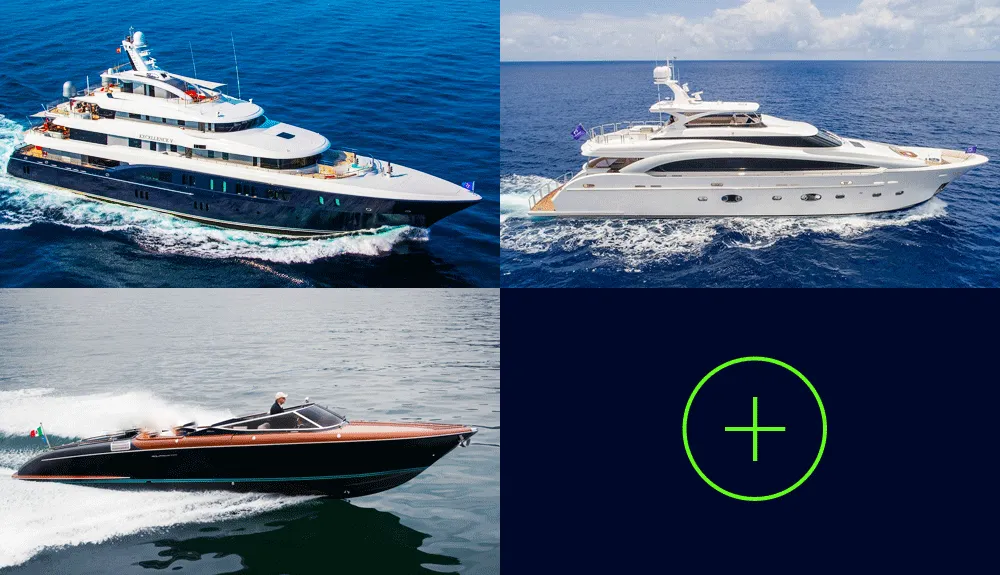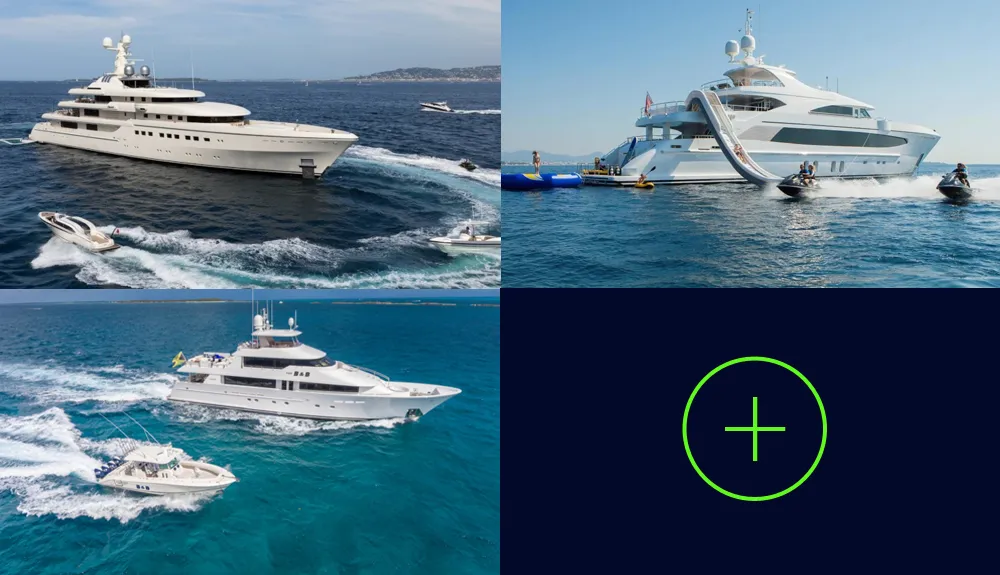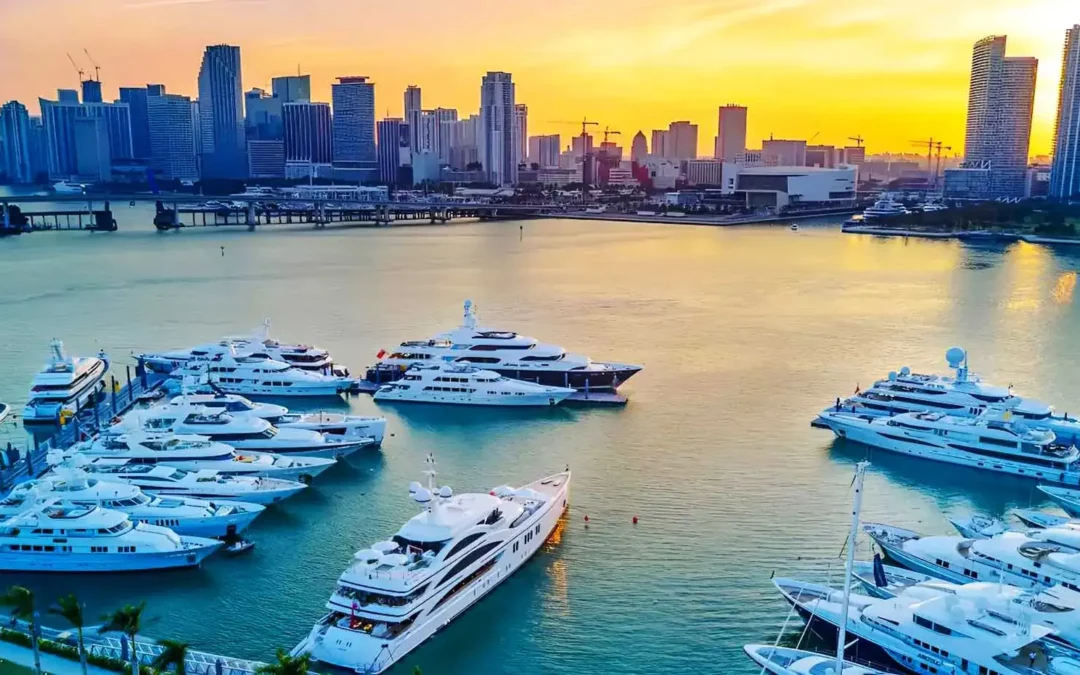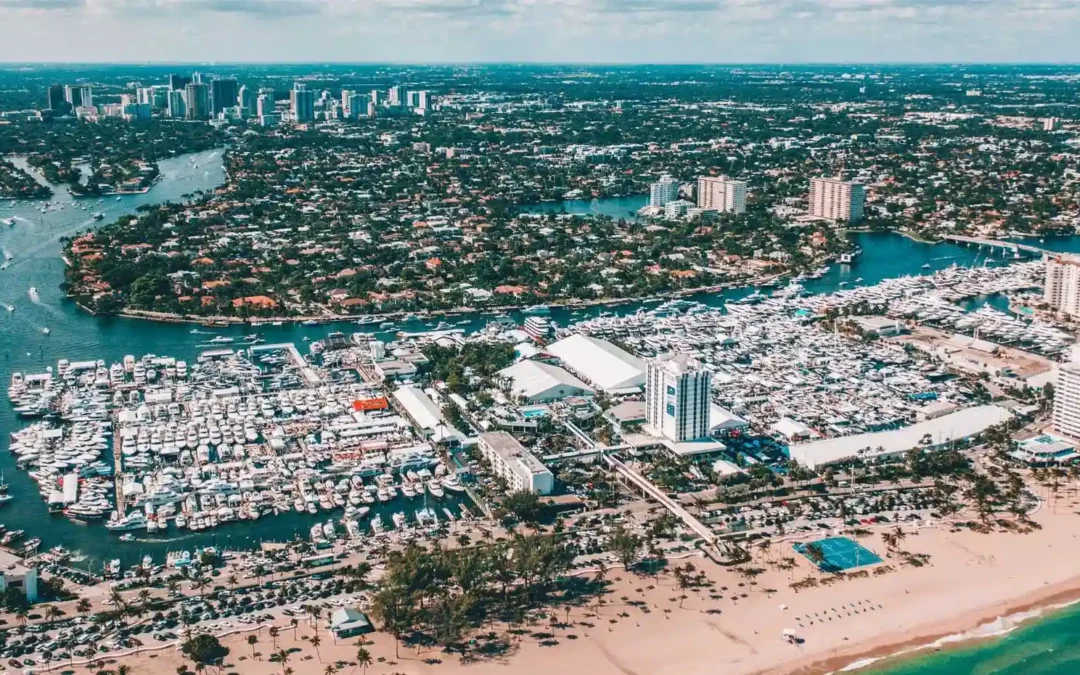5 TIPS ON BUYING A YACHT
Buy a yacht and experience one of life’s greatest rewards; however, it’s important to keep in mind that it’s not just the yacht, the destinations, or the service that ensure an epic yacht ownership experience – instead, it’s the caliber of yacht specialists with whom you surround yourself.
The best guidance comes from experts who have been to every destination, have circumnavigated the globe many times, and know the yachts. With over three decades of global superyacht experience, and guiding clients, we’ve come to know the biggest decision you’ll make on your yachting journey is selecting the right experts to guide you.
Consulting with highly qualified yacht sales and build experts who know the pulse of the market, the shipyards, and every yacht for sale is where it all begins.
Whether you’re looking to build a yacht or buy an existing one, with rock-solid professional guidance at an early stage, avoiding costly mistakes and finding the perfect yacht at the perfect price can easily be achieved. (read guide below)
E
LIVE THE LIME LIFE
For yachts of all sizes, time and time again, clients rely upon the yacht sales specialists at LIME when they purchase a yacht.
On the sales side, we also have relationships with clients and sales brokers looking to sell a yacht they may have privately listed.
With yachts available from 30′ (9m) to 400′ (122m)+, we work with yacht buyers worldwide, before, during, and after their purchase.
We are regarded by industry experts and clients alike, as some of the most knowledgeable yacht sales brokers in the yachting business. (view our Yacht Buying Guide below)
Simply put, we will provide the absolute best yacht intelligence available and rock-solid expertise to make your yacht-buying experience a fun, seamless, and stress-free process.
Because of our experience and unique skillset, we’re unlike any other yacht brokerage. We have circumnavigated the globe many times in superyachts, have orchestrated countless yacht charter vacations, and know the best, and the worst, yachts and builders.
We have also managed, specified, built, operated, designed, chartered, brokered, and marketed some of the most recognized luxury yachts on the water.
We happily share our 30 years of real-world knowledge about yachts, along with the destinations they crusie, and remain at your side as a valuable resource throughout all phases of your yacht ownership, and beyond.
STEP BY STEP CHECKLIST
Below are the top 10 questions and answers asked by individuals looking to buy a yacht. To access our comprehensive, step-by-step guide to buying a yacht, don’t hesitate to download our exclusive “Buy a Yacht Guide and Checklist”.
To further enhance your understanding of the yacht buying process, keep scrolling down for additional valuable tips, essential steps, and exclusive insider knowledge that will guide you in finding the perfect yacht.
For additional expert insights, comprehensive answers to the top 20 questions about buying a yacht, and much more, request a consultation with a luxury yacht expert at LIME.
We are a full-service luxury yacht sales brokerage that provides tailored guidance, backed by decades of experience. We have, and continue to guide clients worldwide, with headquarters and yacht brokers located in Fort Lauderdale, Florida.
INSIDE THE YACHT BUYERS GUIDE
Expert Insights: Knowledge and expertise provided by seasoned experts.
Personalized Assistance: Discover how only a tailored experience will protect and achieve your vision.
Buy a Yacht
Guide & Checklist
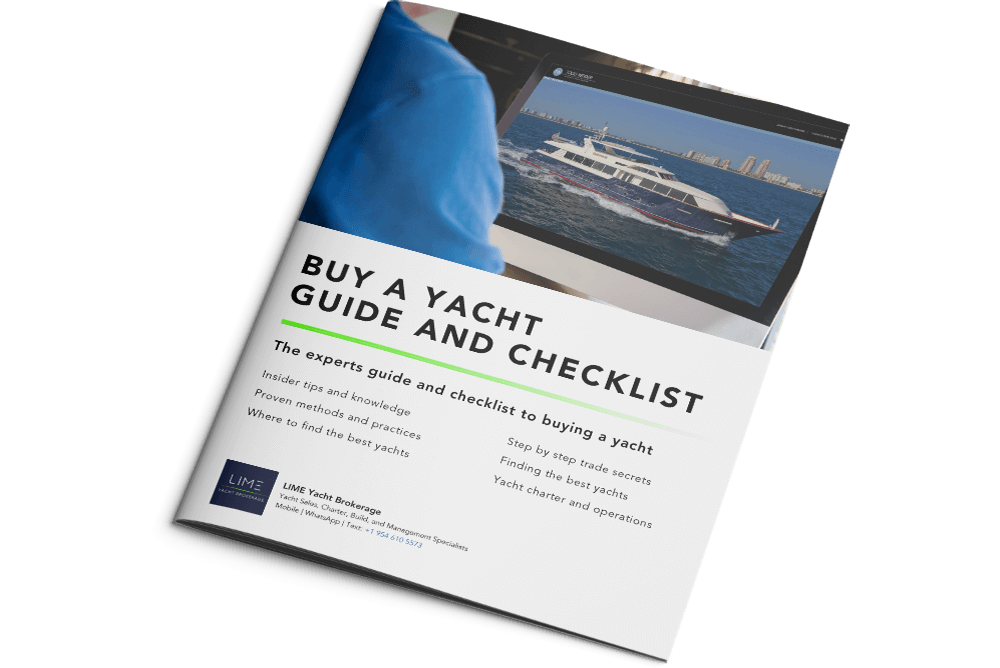
TOP 10 QUESTIONS ABOUT BUYING A YACHT
Is it best to buy a new or used yacht?
How much does a yacht cost to buy?
How much is the cheapest yacht?
What is the annual running cost of a yacht?
How do I get the best price on a yacht?
To get the best price on a yacht you need market intelligence, such as insider knowledge and yacht sales data. Knowing where the best deals are located also helps. A highly qualified yacht broker will have all of these tools, and know the pulse on the market.
Is steel, aluminum or a fiberglass hull best?
The best hull material for a yacht depends on where the yacht will be used and how. Steel is the most popular for bigger yachts and ships, whereas aluminum is popular for near coastal medium-size fast yachts. A fiberglass hull is known to be less maintenance but is also hard to modify, and replacing equipment can be difficult in the long run.
Can I make money chartering my yacht?
How much will the yacht crew cost?
How many staterooms do I need?
What are the best used yachts for sale?
Ask an Expert
Unmatched Real World Experience
WHAT SHOULD I KNOW BEFORE BUYING A YACHT?
Whether you’re ready to buy a small yacht, or even ready to buy a superyacht, many elements need to be considered before you buy a yacht of any kind.
With many types of yachts for sale, and for someone not familiar with the process, it is very easy to end up buying a yacht that does not meet your lifestyle or needs.
Your new yacht will be the gathering place for your closest friends, and family, where you’ll make core memories while celebrating some of your most important events.
Because of this, the guidance of a luxury yacht specialist is remarkably valuable. (see 10 Steps to Buy a Yacht below)
At the core of purchasing the right yacht, and long before considering the layout, styling, and interior design, a list of parameters is considered and decided upon.
This early discovery phase of buying a yacht is the most important time of the yacht-buying process. It ensures you purchase a well-maintained luxury yacht, at the best price, best suited for you and your family’s lifestyle.
Regardless of size, when the time to buy a yacht comes, getting matched up with the right yacht sales broker with real-world expertise on the specific type of yacht you are interested in is the best place to start. They will guide you through the yacht buying process and beyond, making key decisions simple to understand and easy to make.
12 THINGS TO CONSIDER BEFORE YOU BUY A YACHT
For an instant reply, go ahead and send a message (or call) 24/7 at +1-954-507-2030 to a Luxury International Megayacht Expert (LIME).
How Much Does a Yacht Cost?
| 40′-60′ / 12m-18m | $200k – $4M |
| 60′-90′ / 18m-28m | $1M – $8M |
| 90′-120′ /28m-36m | $4M – $10M |
| 120′-150′ / 3m6-45m | $8M – $20M |
| 150′-180′ / 45m-55m | $15M – $35M |
| 180′-200′ / 55m-58m | $20M – $55M |
| 200′-230′ / 60m-70m | $30M – $70M |
| 230′-325′ / 70m-100m | $60M – $220M |
| 325′-550′ / 100m-167m | $200M – $450M |
| 550′ / 167m + | $400M+ |
*Estimates can vary by yacht size, builder, and year built.
**Consult an expert for a current yacht market analysis.
Where to Flag My Yacht?
How to choose your yacht’s flag state (registration) may not be the first thing you consider when ready to buy a yacht, but it may be one of the most important decisions you’ll make. The de facto flag choice for years has often been either the Cayman Islands, Marshall Islands, or St. Vincent. Each of these flag states offers different benefits, including privacy, taxes, exposure to liability, the vessel’s success as a commercial enterprise, and, ultimately, your enjoyment of the yacht.
A flag state is the country or governmental entity under whose laws a vessel is registered or licensed. This can be the country in which the owner resides, or more commonly in the superyacht world, an offshore ship registry in a country with laws that are attuned to the complexities of yacht ownership and charter operations. To discuss yacht registration, along with any questions about yacht ownership, consulta a LIME Yacht Broker.
Yacht Hull Design
Yacht Hull Comparison Guide
BUY A SEMI-DISPLACEMENT VS FULL-DISPLACEMENT YACHT
| Full-Displacement | Semi-Displacement | ||
|---|---|---|---|
| Stability/ Comfort | Slow roll. Generally more comfortable at anchor and underway with a low center of gravity. | Hard/fast roll. Hard chine hull shape, and more often a higher center of gravity. | |
| Volume | Volume considerations have less impact on performance, so hull shapes generally contain more interior volume than a similar length in semi-displacement. This also makes them heavier than semi-displacement yachts, resulting in a more comfortable ride while transiting in rough weather. | When designed initially for speed, semi-displacement models generally have a shallower draft and less interior volume than full-displacement models of the same length. This also makes them lighter than full-displacement yachts, resulting in a less comfortable ride while transiting in rough weather. | |
| Noise | No restriction on build weight allows full implementation of noise attenuation (not all manufacturers employ the necessary construction to minimize noise). | Generally louder interiors whilst underway due to the desire to reduce weight in construction; larger engines and faster water movement. | |
| Fuel Consumption | More fuel-efficient when compared with a semi-displacement yacht. | Very high fuel consumption. Often four to six times the fuel consumption of a similar sized full-displacement yacht. | |
| Speed | Generally, a 10-14 knot cruising speed. The waterline length is the primary factor, then horsepower. | Generally, a 16-26 knot cruising speed. Horsepower is the primary factor, then weight, and the waterline length. | |
| Engine Maintenance | Lower power rating and crew engineers should be capable of maintaining 95% of all engineering needs. | Engineering expertise. High-powered engines can require more maintenance from outside companies and specialists. | |
| Transatlantic Crossings | Capable of crossing the Atlantic on her own bottom. Costs range from $500 to $1,000 per foot depending upon crew size and engine size. The downside is more wear and tear on systems and the yacht, overall. | Less wear and tear on systems and the yacht, overall. With a few exceptions, not normally recommended for transatlantic crossings on her own bottom, but possible using a yacht transporter, or as deck cargo, at a cost ranging from $1,000-$1,600 per foot each way. |
10 Steps to Buy a Yacht and Costs
Professional Insider Expertise
CONTENTS – 10 STEPS TO BUY A YACHT
| Step 1. | Select a Qualified Broker |
| Step 2. | Determine Guests & Amenities |
| Step 3. | Price Range & Budget |
| Step 4. | Confirm Type & Dimensions |
| Step 5. | Search & Selection |
| Step 6. | Make an Offer |
| Step 7. | Negotiations & Enter into Contract |
| Step 8. | Sea Trails & Surveys |
| Step 9. | Acceptance |
| Step 10. | Closing & Handover |
*Consult a qualified yacht expert for the best outcome.
HOW TO BUY A YACHT IN 10 STEPS
1. Select a Qualified Yacht Broker
When you’re ready to buy a yacht, having expert knowledge of the current marketplace and inside information is crucial to locating the best yachts available for purchase.
While many yacht brokers will jump at the opportunity to offer their services, only a few have the right experience, tools for the job, and their pulse on the marketplace, who can also guide you safely to the closing table.
For this reason, choosing a qualified yacht broker in your search to buy a yacht is the most important decision you’ll make. Doing so positions yourself for the best possible outcome, and keeps you from wasting a lot of time and energy.
To help with the process of choosing a qualified yacht broker, download the Best Yacht Broker Comparison Guide for free. (see below)
Further, it might be tempting to buy a yacht from a discount or less reputable yacht broker, or even an individual private seller, however, this will significantly increase the risk of making a costly mistake.
Always work with a reputable yacht broker, who has a reputation to protect and uphold. Private sellers have far less to lose, as they usually have only one or two boats to sell. So a bad reputation won’t affect them much.
When it comes to a reputable yacht broker, one unsatisfied customer can ruin the image they took years to nurture and build.
A qualified yacht broker will go the extra mile to make sure you are happy and satisfied because a satisfied yacht buyer significantly improves the potential of repeat business or a referral.
E
OWN YOUR FUTURE
2. Decide on Type, Length, and How Many Guests
With hundreds, even thousands of yachts for sale, narrowing down the available yachts to purchase can be confusing.
While most buyers have an idea about the type, length, and number of guests for their next yacht, it’s important to know yachts are usually built to cruise specific regions of the world.
They are not always intended to be used in all types of sea conditions either. For example, a 120-foot yacht may be less suitable and have less room and comfort, than a 100-foot yacht with specific features and design criteria.
There are also limitations on the number of guests a yacht can carry, even though they may have space for more guests aboard.
With length also comes tonnage, and with tonnage comes rules and regulations that can cost a yacht owner significantly more than they may need to spend.
Note: A larger yacht does not always mean it is certified to legally carry more guests. Knowing specific thresholds, regulations, and the intended purpose a yacht was built for, can save even the most seasoned yacht owners significant amounts of money when purchasing a yacht for sale.
3. Determine a Price Range
According to current market conditions and sales data sampled from proprietary data maintained by the yacht sales experts of LIME, in 2021, the average price of a previously owned luxury yacht for sale is estimated at USD $10.54 million (€8.9 million )
Luxury yachts can start at around $2.5 million for a smaller or late model yacht, and rise to USD $500-$600 million, which is how much the largest yacht in the world built by Lurssen Yachts, the 590 feet (179.8m) Azzam, cost to build.
Yachts are a significant investment and range from production construction to fully custom.
Production yachts, or yachts that are produced to the same specifications, materials, and styling, and manufactured and/or assembled by production yacht builders, generally start around $500,000 and go above USD $10 million.
Semi-custom and fully custom yachts are considerably more expensive. This is primarily because everything is built to a unique specification, one at a time.
A semi-custom yacht averages about USD $25 million, while a fully custom yacht, built by a pedigree yacht builder and styled by a leading yacht designer (depending on her size) can reach USD $100 million and well beyond.
Another option to consider is buying a previously owned yacht, or a yacht with some character and history attached to it. This brings the initial cost down and is also good if you prefer to customize the interior of the yacht to your exact requirements.
You can use the money you save on the initial cost to refit and customize it to your taste.
Once you’ve decided to buy a yacht, there’s a lot to consider, and the price range is among the most important. Luxury yacht prices, like the yachts themselves, differ enormously.
Yacht specialists of LIME are experts in this field. Their proprietary AI engine, Yacht Data IQ, maintains data on yachts for sale and sold yachts, and will guide you on everything you need to know about pricing.
By analyzing the present, and historical sales data from yacht manufacturers and closed yacht sales around the world, they can advise you on what certain yachts will cost, including trends in the global marketplace.
4. Search and Selection
Yachts for sale are available through many sources, and because of this, working with a yacht specialist will pay huge dividends.
A qualified yacht sales broker will have access to yachts for sale publicly, but the best yacht sales brokers also have access to privately listed yachts as well, making certain your search to buy a yacht includes every yacht for sale.
LIME, located in Fort Lauderdale, Florida, works worldwide. When you work with us, we refine your requirements. Because we know the yachts and have been on them, we can easily provide you with a list of suitable yachts worth viewing to ensure you don’t waste any of your valuable time.
A well-versed yacht broker will know the best yachts available, the most motivated sellers, and the persons to contact for an up-to-the-minute status and location of each yacht.
Inspections can be made at a regularly scheduled boat show or by special appointment, subject to the yacht’s availability.
5. Make an Offer
Once a yacht or yachts are selected, the buyer makes a formal offer(s), which is drawn up and presented by your broker, using an industry-standard contract to buy a yacht.
This purchase and sales agreement (PSA) outlines the deposit, timing for the sea trial, survey, acceptance, financing, warranties, requirements, force majeure, additional terms, and closing.
When making your offer, it’s normal to deposit 10% of the offer price into escrow with your attorney or broker, usually within a certain period after acceptance. This demonstrates to the seller that you are serious and ready to buy a yacht.
It is also wise that your offer includes a list of all documents and certificates the seller’s side will deliver at closing, as well as an accurate and complete inventory of the vessel.
Especially when buying a larger yacht, it’s important your yacht sale broker is knowledgeable about the documents required for each vessel. Not knowing which documents to include can be a very costly mistake for the yacht buyer.
6. Offer Accepted
The seller accepts, rejects, or counters your offer to buy. It is rare for the first submitted offer to be accepted. It can take as long as seven to fourteen days for both the yacht buyer and seller to agree on terms and conditions. This is where the expertise of a well-qualified yacht sales broker shines.
The best yacht brokers will know how to build and present a market analysis that will include comparable yachts, which will then support your offer, and the repairs and/or improvements each yacht needs.
7. Survey
Depending upon the size of the yacht, the survey can take from just one day to as many as a few weeks to complete.
During the survey, all mechanical, electrical, and electronic equipment is tested, often by specialists in each field.
The objective of the survey is to get an accurate understanding of the vessel’s current condition and precisely how much the yacht will cost to maintain over the next few years.
As part of the survey, one of the general conditions is to haul the vessel out of the water for inspection. The cost of the survey and haul-out is paid for by the buyer.
8. Sea Trial
At a convenient time before, during, or after the survey, the prospective yacht buyer is provided an opportunity to take the yacht out to sea to establish the vessel’s performance underway.
This sea trial, usually limited in duration to 4 hours, is normally at the seller’s expense.
During the sea trial, the engines are tested to verify cruising and maximum speed. Decibel readings are taken. Electrical loads are put on the generators.
Electronics and navigation equipment is tested, and the overall motion of the yacht underway, and at rest, is observed and documented.
Depending on the type and size of the yacht, sea trials may be more in-depth and include more tests and readings of systems and equipment.
9. Acceptance
Following a successful survey and sea trial, the yacht buyer will convey acceptance of the yacht to the buyer’s yacht broker, who then submits written acceptance of the vessel to the seller’s side.
A conditional acceptance of a yacht is when the yacht is accepted by the buyer, with conditions to be met. So long as the seller agrees to the conditions, the purchase of the vessel continues to move forward.
From this point onward, the 10% escrow deposit is at risk should the buyer not close on the sale of the yacht at the agreed-upon closing date.
Note: It’s also very normal for deficiencies found during the survey to be included in a conditional acceptance that gives the seller time to make repairs, or allows a financial allowance for the buyer to make repairs after the closing.
For example, if a deficiency is found in the shaft alignment that cannot be repaired before closing, a conditional acceptance is signed by both the buyer and seller, where a reduced dollar amount from the previously agreed price is awarded in consideration for the shaft alignment condition.
10. Closing & Handover
Similar to purchasing an automobile or real estate, a yacht closing is a fairly straightforward exchange of certificates and signatures on important documents.
The protocol of delivery and acceptance lists the location and time of the ownership exchange.
It’s also important that your broker is knowledgeable and familiar with documents that need to be current, and not expired.
This can include COFR (certificate of financial responsibility), warranty certificates, tonnage certificates, builders’ certificates, classification, and regulatory certificates, among others.
At closing, the buyer should have a new registration and insurance already coordinated.
Yacht brokerage LIME has extensive experience and knowledge. They know which certificates and documents you’ll want to request when submitting your offer.
They also have real-world experience with maintaining such documents and working with regulatory bodies worldwide, and will happily assist any new buyer in establishing the necessary official papers and insurance required.
E
MESSAGE AN EXPERT
E
MESSAGE AN EXPERT
Go ahead and schedule your complimentary introductory consultation with a yacht sales broker at LIME for insider information, and how their proven yacht-buying techniques work.
Contact a Luxury International Megayacht Expert.
To begin your epic experience, take the next step and contact the yacht specialists of LIME. We are happy to talk about yachts at any time.
Simply use WhatsApp, call, or send a text 24/7 at +1-954-507-2030 for anything you’d like to know about buying or owning a yacht.
10 Steps to Buy a Yacht
| Step 1. | Select a Qualified Broker |
| Step 2. | Determine Guests & Amenities |
| Step 3. | Price Range & Budget |
| Step 4. | Confirm Type & Dimensions |
| Step 5. | Search & Selection |
| Step 6. | Make an Offer |
| Step 7. | Negotiations & Enter into Contract |
| Step 8. | Sea Trails & Surveys |
| Step 9. | Acceptance |
| Step 10. | Closing & Handover |
*Consult a qualified yacht expert for the best outcome.
How Much Do Yacht Crew Cost?
Whats it Cost to Own a Yacht?
| Dockage | $350,000 |
| Fuel | $300,000 |
| Crew Salaries | $1,000,000 |
| Insurance | $90,000 |
| Communications | $50,000 |
| Maintenance & Repairs | $1,150,000 |
| Crew Uniforms | $35,000 |
| Crew Provisions | $120,000 |
| Owner Provisions | $100,000 |
| Medical Supplies | $15,000 |
*Estimates vary greatly by yacht size, condition, and use.
**Consult with a yacht expert to discuss your operating program.
LIME Time
Subscribe for free.






